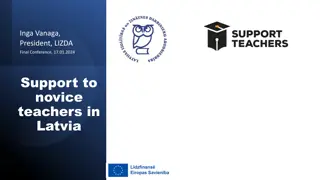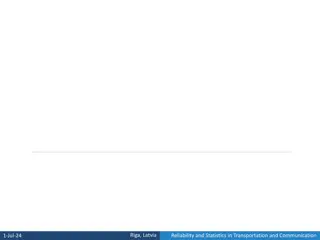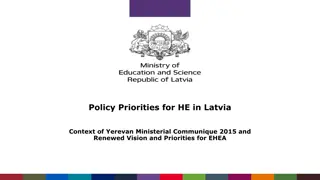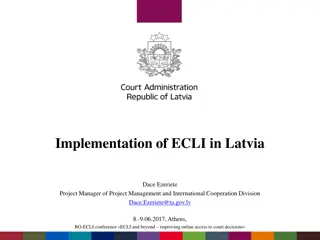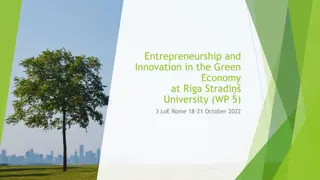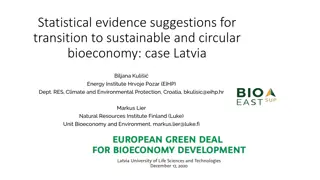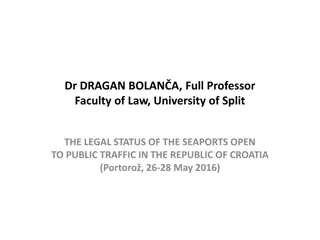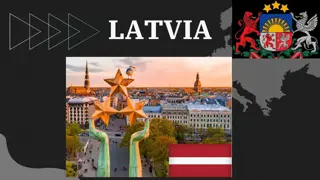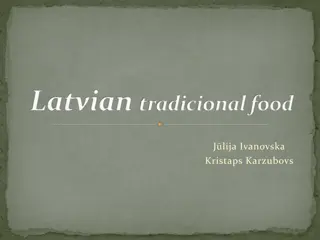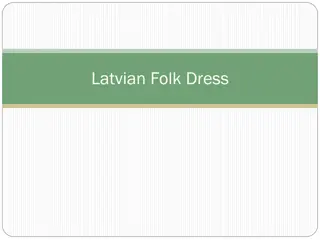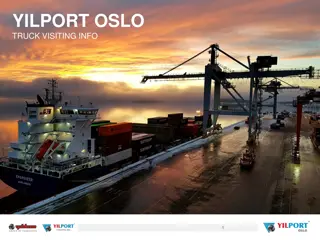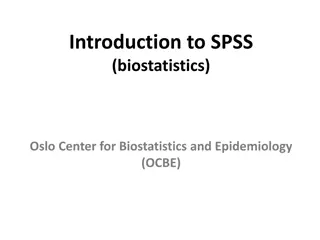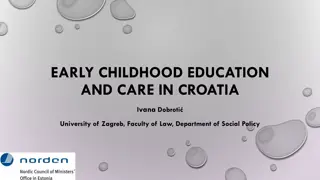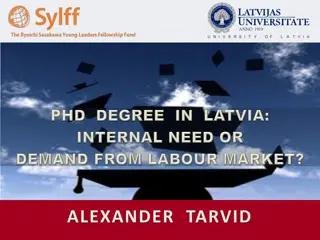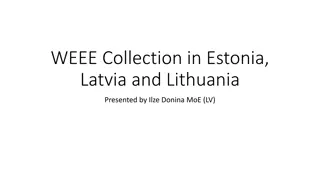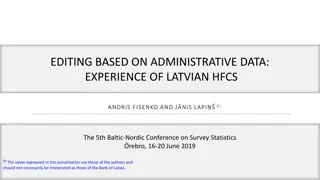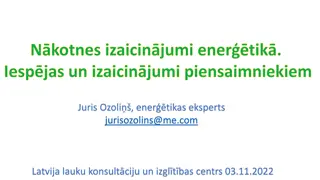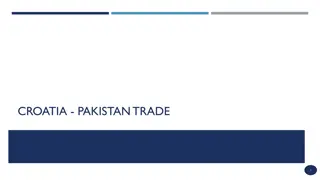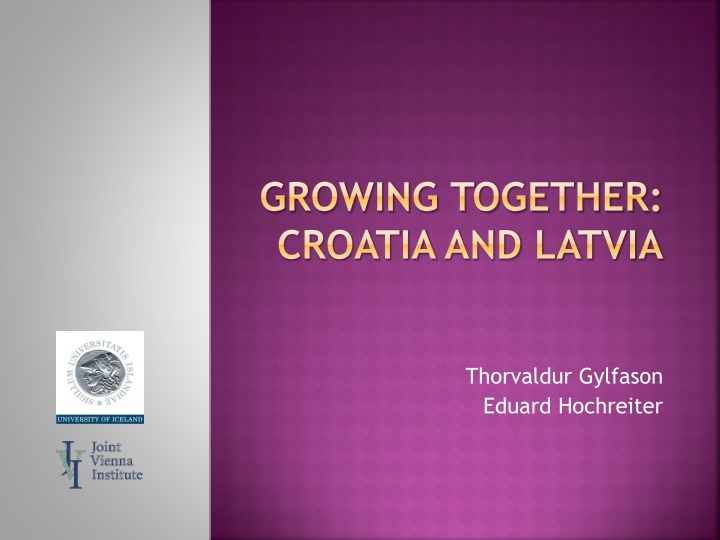
Comparing Growth: Croatia vs Latvia - A Study in Economic Development
Discover the economic trajectories of Croatia and Latvia since the collapse of the Soviet Union, examining their GDP per capita, investment patterns, and human capital contributions. Explore how these countries have navigated intensive versus extensive growth models and the impacts on their development.
Download Presentation

Please find below an Image/Link to download the presentation.
The content on the website is provided AS IS for your information and personal use only. It may not be sold, licensed, or shared on other websites without obtaining consent from the author. If you encounter any issues during the download, it is possible that the publisher has removed the file from their server.
You are allowed to download the files provided on this website for personal or commercial use, subject to the condition that they are used lawfully. All files are the property of their respective owners.
The content on the website is provided AS IS for your information and personal use only. It may not be sold, licensed, or shared on other websites without obtaining consent from the author.
E N D
Presentation Transcript
GROWING TOGETHER: CROATIAAND LATVIA Thorvaldur Gylfason Eduard Hochreiter
INTRODUCTION Since collapse of Soviet Union in 1991 Three Baltic states, now EU members, have fared significantly better than other FSU states How did they fare compared with former Yugoslavia? Aim is to apply standard growth economics to a comparison of Croatia and Latvia Extensive vs. intensive growth Similarities Small, no natural resources, history of foreign rule Differences Boom followed by bust in Latvia in 2000s Less rapid and less volatile growth in Croatia
BACKGROUND Earlier paper compared Estonia and Georgia by reviewing main determinants of their growth Estonia beat Georgia on virtually every score Hence, small surprise that Estonia and Georgia grew apart after 1991 Based on simple growth accounting, education and efficiency made similar contributions to growth, while investment made a relatively minor contribution Intensive rather than extensive growth Here we report by similar methods how Croatia and Latvia grew together Latvia caught up, but Croatia remains ahead
GDP PER CAPITA 1991-2008 (CURRENT INTERNATIONAL $, PPP) Croatia and Latvia s per capita GDP sank by 33% to 50% in real terms 1989-93, and grew thereafter From 1991, Latvia s per capita GDP has risen from 79% of Croatia s per capita GNI to 90% in 2008 Slovenia Estonia Lithuania Croatia Latvia Serbia 2008 1991 Montenegro Macedonia, FYR Bosnia and Herzegovina 0.00 5.00 10.00 15.00 20.00 25.00 30.00 Thousands
GDP PER CAPITA 1980-2008 (CONSTANT 2005 INTERNATIONAL $, PPP) Latvia took a deeper and longer lasting plunge Its per capita GDP fell by almost a half 1989-93 Croatia s per capita GDP contracted by a third 1990-93 20000 Croatia 18000 Latvia 16000 14000 12000 10000 8000 6000 4000 2000 0
BEGIN WITH THREE KEY DETERMINANTS OF GROWTH Real capital Investment in machinery and equipment Human capital Education, on-the- job training, and health care Foreign capital Trade and investment Growth Investment Education Trade
THEN ADD FIVE FURTHER DETERMINANTS OF GROWTH Financial capital Liquidity and low inflation grease the wheels of production and exchange Flexible labor Social capital adds to cohesion Honesty Democracy Equality Growth Labor market Democracy Liquidity Equality Honesty
OUTLINE OF EVIDENCE Compare Croatia and Latvia in terms of determinants of growth Investment, education, and health Trade, inflation, and economic structure Labor market institutions Democracy and equality Governance indicators
INVESTMENT 1980-2008 (% OF GDP) Both countries have seen a surge of investment in machinery and equipment Latvia invested 27% of GDP on average 1990-2007 compared with 21% in Croatia 45 40 35 30 25 20 15 Croatia 10 Latvia 5 0
SECONDARY-SCHOOL ENROLLMENT 1981-2008 (%, GROSS) Nearly all Latvian kids attend secondary schools compared with 90% in Croatia Over two thirds of young Latvians go to college against 41% in Croatia Expenditure on education 1998-2007 was 5.5% of GDP in Latvia compared with 4.5% in Croatia Declining trend in Latvia Rising trend in Croatia 120 100 80 60 Croatia 40 Latvia 20 0
LIFE EXPECTANCY 1960-2007 (YEARS) Life expectancy at birth took a deep dive in Latvia before 1990, did not recover until a decade later, and remains 5 years below that of Croatia Expenditure on health care 2002-2007 was 7.5% of GDP in Croatia compared with 6.2% in Latvia 78 Croatia 76 Latvia 74 72 70 68 66 64 62 60
EXPORTS OF GOODS AND SERVICES 1990-2008 (% OF GDP) Exports from Latvia equaled 47% of GDP on average 1991-2007 compared with 44% in Croatia Export figures include re-exports 90 Croatia 80 Latvia 70 60 50 40 30 20 10 0
IMPORT DUTIES 1991-2007 (% OF TAX REVENUE) Latvia basically slashed all tariffs, as did Croatia, which started from a much higher initial level of tariff incidence It takes 1.7 days for importers in Latvia to clear customs compared with 2 days in Croatia 20 Croatia 18 Latvia 16 14 12 10 8 6 4 2 0
INFLATION 1991-2008 (GDP DEFLATOR, ANNUAL %) Croatia initially had higher inflation than Latvia, but managed from 1996 onward to keep inflation in single-digit figures In Croatia, severe initial monetary overhang 1600 1400 Croatia 1200 Latvia 1000 800 600 400 200 0
MONEY AND QUASI-MONEY (M2) 1994-2008 (% OF GDP) In Croatia, inflation was below 5% a year on average 1996-2008 against 8% in Latvia Process of monetization was accordingly more rapid in Croatia than in Latvia 70 Croatia 60 Latvia 50 40 30 20 10 0
INTEREST SPREAD 1994-2008 (% OF GDP) Interest spread between lending and deposit rates fell by more in Latvia than in Croatia Almost all bank assets are now foreign-owned in Latvia, less so in Croatia 30 Croatia 25 Latvia 20 15 10 5 0
INTEREST SPREAD 1994-2008 (% OF GDP) Lower spread in Latvia may suggest more competitive banking or higher credit risks than in Croatia Declining interest spread suggests more competition in both countries banking system 30 Croatia 25 Latvia 20 15 10 5 0
AGRICULTURE 1980-2008 (VALUE ADDED, % OF GDP) Agriculture s share of GDP in Latvia has decreased to 4% compared with 7% in Croatia Reflects Latvia s strong emphasis on economic modernization 25 20 15 10 Croatia 5 Latvia 0
MANUFACTURES EXPORTS 1992- 2007 (% OF MERCHANDISE EXPORTS) Manufacturing 1992- 2007 hovered around 70% of Croatia s exports compared with 60% in Latvia World Bank s Ease of Doing Business Index now (2010) puts Latvia in 27thplace out of 183 and Croatia in 103rd, up from 110thplace before 90 80 70 60 50 40 Croatia 30 Latvia 20 10 0
MANUFACTURES EXPORTS 1992- 2007 (% OF MERCHANDISE EXPORTS) In 2005, tax rates were cited as a major business constraint by 34% of managers surveyed in Croatia compared with 69% of managers in Latvia 90 80 70 60 50 40 Croatia 30 Latvia 20 10 0
ECONOMIC FREEDOM 1996-2010 (INDEX) Both countries have gradually liberalized on many fronts at once according to the Economic Freedom Index Source: Heritage Foundation 80 70 60 50 40 30 Croatia 20 Latvia 10 0
DEMOCRACY 1991-2004 (INDEX) Democratization as investment in social capital Infrastructural glue that holds society together and keeps it in smooth and harmonious working order Croatia embraced democracy a decade after Latvia and still scores a point lower 10 8 6 Croatia 4 Latvia 2 0 -2 -4 -6
DEMOCRACY 1991-2004 (INDEX) Croatians have less confidence in the court system In Croatia, 27% of managers surveyed described the functioning of the courts as a major business constraint compared with 21% in Latvia 10 8 6 Croatia 4 Latvia 2 0 -2 -4 -6
DEMOCRACY 1991-2004 (INDEX) Yet, Croatians are less concerned about crime In Croatia, 10% of the managers surveyed described crime as a major business constraint compared with 26% in Latvia 10 8 6 Croatia 4 Latvia 2 0 -2 -4 -6
CORRUPTION 1998-2008 (INDEX) Both countries have made progress against corruption as measured by the corruption perceptions index Source: Transparency International 6 5 4 3 2 Croatia 1 Latvia 0
CORRUPTION 1998-2008 (INDEX) In Croatia, 19% of managers surveyed described corruption as a major constraint on their business operations in 2007 against 33% in Latvia in 2009 A few years earlier, it was the other way round: Croatia 27% against Latvia 16% 6 5 4 3 2 Croatia 1 Latvia 0
GINI INDEX OF INEQUALITY Inequality has increased more in Latvia than in Croatia, but remains similar to the rest of continental Europe 40 Croatia 35 Latvia 30 25 20 15 10 5 0 1988 1998 2004-5
ANALYTICAL BACKGROUND Per capita output depends on Efficiency, A Trade, governance Human capital per person, H/L Education, health Capital/labor ratio, K/L Investment Natural capital per person, N/L We assume c = 0
ACCOUNTING FOR THE INCOME DIFFERENTIAL Suppose a = b = 1/3, c = 0 Assume v = 0.1 u = years of schooling By definition, K/Y is proportional to I/Y
ACCOUNTING FOR THE INCOME DIFFERENTIAL Assume v, g, and are the same in Croatia and Latvia
ACCOUNTING FOR THE INCOME DIFFERENTIAL Decomposition of 2008 per capita income differential of 10% Investment rates are 0.21 and 0.27 Would by itself account for a 13% (i.e., 1/0.885 - 1) difference in per capita incomes in Latvia s favor School life expectancy is 12.5 and 14.5 years Would by itself account for a 172% (i.e., 1/0.368 - 1) difference in per capita incomes in Latvia s favor So, education makes a much larger contribution than investment (or labor market institutions, for that matter)
ACCOUNTING FOR THE INCOME DIFFERENTIAL Despite Latvia s advantages in terms of education and investment, Croatia s per capita GDP remains ahead This must mean that Croatia has efficiency advantages vis- -vis Latvia Specifically, our computations leave a 125% residual difference in efficiency, including governance, in Croatia s favor 131% if we include labor market variables Intensive growth counts, not extensive growth
PARAMETER VALUES Investment (% of GDP) School life expectancy (Years) Hours of work per person per week Efficiency (Latvia = 100) Per capita GDP 2008 (Dollars at ppp) Latvia Croatia 27 21 14.5 12.5 21.4 19.7 100 231 15,590 17,220
CONCLUSION Latvia invested more relative to GDP than Croatia, and also attracted a bit more FDI Latvia sends more young people to secondary schools as well as to colleges and universities than Croatia But, Croatia has some advantages vis- -vis Latvia that enhanced economic efficiency Longer lives Less inflation More manufacturing exports More economic freedom On balance, Latvia caught up, but Croatia remains ahead

